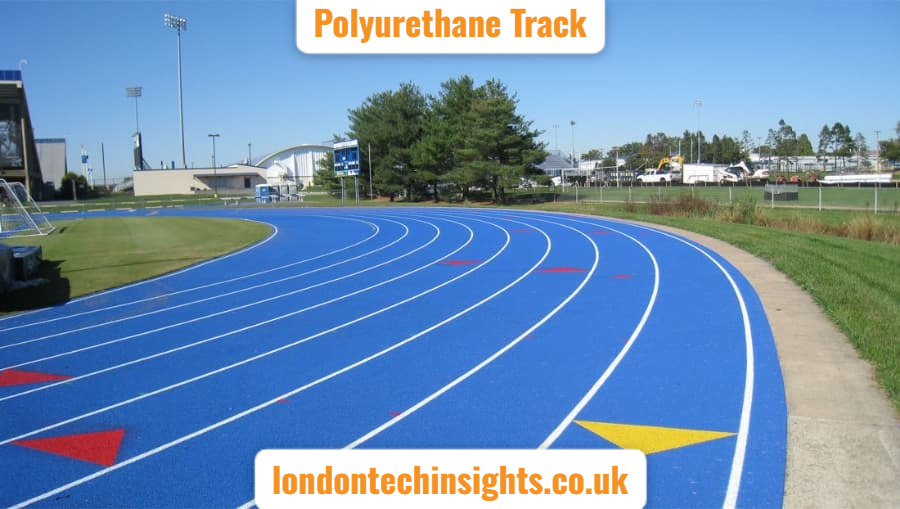
What Is a Polyurethane Track?
A polyurethane track is a high-performance athletic surface designed for durability, safety, and competitive sports. This synthetic track material is created using a multi-layer flooring system that provides consistent support for track and field events. Whether used in a school athletics field or a professional stadium, it offers elasticity, weather resistance, and excellent shock absorption.
This surface has become the standard for outdoor sport infrastructure due to its seamless track construction. The high-performance surface minimizes injury risk and maximizes athletic output. Unlike older surfaces, such as cinder or clay, polyurethane tracks are slip-resistant and UV-resistant, making them suitable for both indoor and outdoor tracks.
Why Polyurethane Tracks Lead in Sports Flooring
Polyurethane tracks have transformed how athletes train and compete. These surfaces are made with rubberized sports materials that reduce impact on joints, thanks to their elastic rebound quality. The shock-absorbing layer in the track material is engineered to prevent long-term athlete fatigue and injury.
Additionally, polyurethane tracks meet IAAF standards for international competitions. They’re installed using either the spray system track, sandwich system track, or the full PU system, each offering varying levels of spike resistance and durability. From school-level events to Olympic-level surfaces, these tracks deliver consistent performance.
How Polyurethane Tracks Are Constructed
The construction of a polyurethane athletics track involves several technical steps. It begins with base leveling, followed by installation of rubber granules that form the bottom layer. Then a binder is used to attach these layers firmly. After that, EPDM granules are layered with a PU coating on top to form the final surface. This layered system ensures that the surface is resilient and long-lasting.
Among the various options, the full PU system provides the highest endurance and shock absorption, while the sandwich system combines rubber and polyurethane layers for balanced performance. Each system complies with the required safety and comfort levels for athletes.
Types of Track Systems Available
There are three main systems used in polyurethane track installations. Each type differs in layering, cost, and long-term benefits. The spray system is cost-effective and best for community fields. The sandwich system offers improved resilience. The full PU system is ideal for high-level competition environments due to its superior performance and track durability.
| Track System | Key Features | Best Use Case |
| Spray System Track | Affordable, quick installation | School or community fields |
| Sandwich System Track | Mid-range performance and durability | Colleges and semi-pro arenas |
| Full PU System | Maximum rebound and spike resistance | Olympic and elite stadiums |
Advantages of Polyurethane Track Surfaces
Polyurethane tracks offer a long list of advantages for athletic use. First, they are weather-resistant, withstanding extreme heat, rain, and cold. Second, their slip-resistant track surface ensures athletes can perform safely in all conditions. They also provide consistent traction and seamless track construction, helping reduce muscle fatigue.
The surface’s anti-slip coating and UV resistant properties extend its life. These tracks also feature custom track designs and precise track line markings, making them suitable for branding or institutional personalization.
Applications in Track and Field Events
These tracks are specifically designed for track and field events, including sprints, hurdles, relays, long jump runways, and more. They offer the necessary grip and bounce to support all types of movement. Athletes rely on polyurethane tracks for their consistent feel and reduced injury risk.
Events like long jump and high jump require optimal take-off and landing zones, which polyurethane surfaces accommodate easily. The elastic structure of the material enhances athlete performance while minimizing stress on joints.
Thickness and Line Marking Details
The standard running lane thickness for polyurethane tracks ranges from 13 to 15 millimeters. This measurement ensures optimal support and energy return for runners. Precision in thickness also supports athlete safety and durability of the surface.
Track line markings are applied with specialized coatings that resist weather damage. These markings are bright, long-lasting, and comply with IAAF standards, which is essential for professional sports tracks and competitions.
Eco-Friendly and Safe Design
One of the lesser-known advantages of polyurethane tracks is their eco-friendly nature. They use non-toxic, recyclable materials that meet environmental standards. These tracks minimize water usage due to their low-maintenance surface and reduce the need for chemical cleaning agents.
Safety is also enhanced by the anti-slip coating and elastic rebound system. These tracks are designed to minimize injuries, offering a safe environment for athletes of all ages and levels.
Ideal for Indoor and Outdoor Use
Whether installed in an indoor arena or outdoor field, polyurethane track surfaces adapt well. Their weather-resistant coating allows them to retain grip and elasticity in wet or dry conditions. This makes them perfect for multipurpose stadiums that host events throughout the year.
Indoor and outdoor tracks benefit equally from the shock-absorbing surface. For schools or universities that use both types of tracks, polyurethane offers unmatched flexibility and performance consistency.
Customization Options and Branding
Modern sports arenas and educational institutions often prefer customized track surfaces. Polyurethane tracks support a wide range of design options, from custom logos to school colors and lane highlights. These tracks allow for creative track line markings without affecting performance.
Custom track designs can include everything from running lanes and hurdle paths to long jump and pole vault zones. This versatility enhances the visual appeal and branding of sports facilities.
Cleaning and Maintenance Guidelines
Maintenance of polyurethane tracks is straightforward. Regular cleaning of debris like leaves and dirt keeps the surface functional. Occasional inspections for cracks or damage ensure long-term durability.
Using appropriate tools and avoiding harsh chemicals helps maintain the coating and anti-slip features. With basic care, these tracks can function optimally for over a decade, making them a cost-effective investment.
Use in Schools and Public Facilities
Public schools, colleges, and municipalities prefer polyurethane tracks for their resilience and low maintenance. These tracks withstand heavy foot traffic and are ideal for physical education classes, athletic meets, and community events.
They ensure student safety while encouraging sports participation. School athletics fields with these tracks experience fewer injuries and improved athlete performance due to the surface’s consistent support.
Cost Estimation and Investment Value
The cost of installing a polyurethane track depends on the surface system chosen, the area covered, and design complexity. On average, the price ranges from $30 to $80 per square meter. Full PU systems cost more initially but offer better longevity and performance.
When comparing cost to long-term value, polyurethane tracks prove to be a smart investment for any institution or sports facility. Their low maintenance and long lifespan make them more economical than many traditional surfaces.
Expert Opinions and Usage Trends
Industry experts consider polyurethane tracks the gold standard for competitive sports environments. Coaches and athletes often cite the surface’s balance of speed and cushioning as key to performance enhancement. With increasing awareness of safety and sustainability, more institutions are switching to polyurethane-based flooring.
Recent trends also show a rise in demand for modular polyurethane surfaces that can be adapted or repaired easily, supporting flexibility and cost-saving in sports infrastructure.
Conclusion: Why Polyurethane Tracks Are the Future
Polyurethane tracks are redefining modern athletics. They combine safety, performance, and sustainability into one unified system. From seamless track construction to resilient flooring material, they provide everything a modern athlete needs to excel. These tracks offer consistent traction, better shock absorption, and low environmental impact, making them the top choice for schools, sports complexes, and Olympic venues alike.
Whether you’re building a new stadium or upgrading an existing field, investing in polyurethane track surfaces ensures long-term value and world-class performance for athletes.
FAQs
Q1: How long does a polyurethane track last with regular use?
With proper maintenance, a polyurethane track can last between 8 to 12 years, depending on climate and usage.
Q2: Are polyurethane tracks suitable for schools and public fields?
Yes, they are ideal due to their durability, low maintenance, and athlete-friendly design for both children and adults.
Q3: What’s the difference between sandwich system and full PU system?
The sandwich system uses a mix of rubber and polyurethane, while the full PU system uses only polyurethane for higher durability and better athletic performance.





